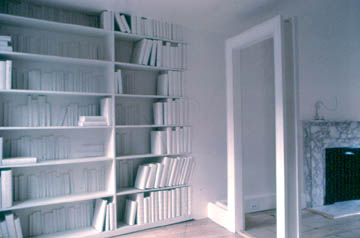|
Built in 1826 in Greenwich
Village, the house is developed as a context for the contemporary lifestyle
of its inhabitants. The concept is about historical layering, and the
walls of the house and garden become membranes separating past and present.
Memories of the past of the house and its occupants in the form of furniture,
clothing, doors, windows, fireplace mantle, bookcase with books, among
others, float partially out through the plaster wall planes.
The final coat of
white paint forms a monochromatic skin over the walls and memory/objects.
If this skin were broken, past and present might meet in the house. The
life of the family and contemporary furnishings form the final layer,
the present and future of the house.
The memories are all
real, found, objects. Several of these were uncovered during the excavation
and renovation. These elements are both mysterious and functional. They
psychologically 'open' the walls to a realm beyond, expanding your perception
and experience of the space.
The memories are less
about providing answers than about raising questions. During construction,
a photograph fell to the floor, out of a wall that had been opened. This
mysterious portrait of a woman from another century, whose identity is
unknown, seems to embody the appropriateness of a concept which links
the elusive past to the present.
|





